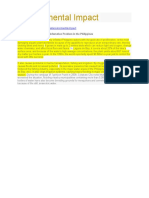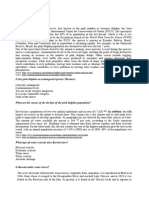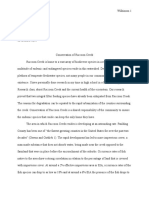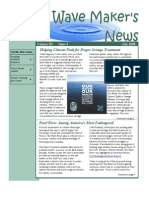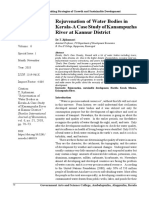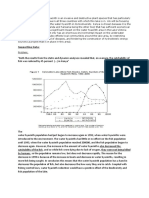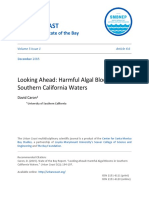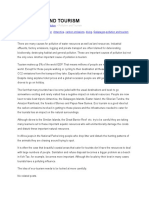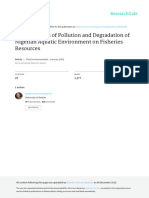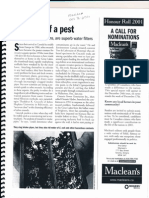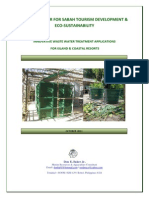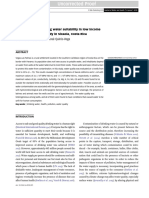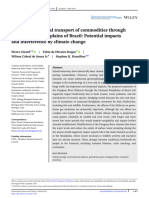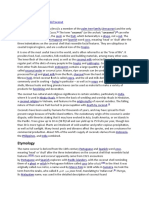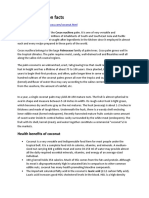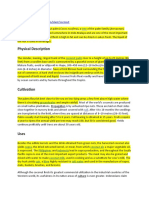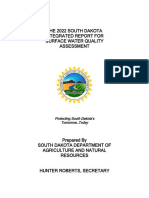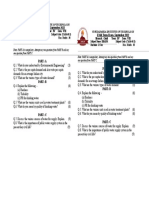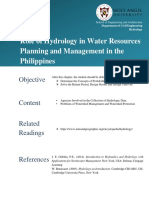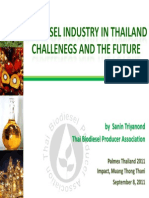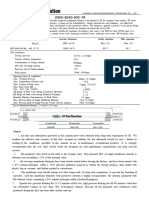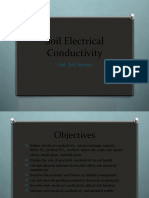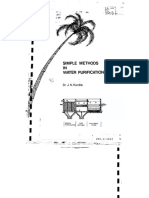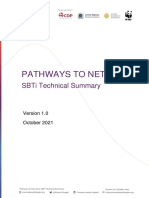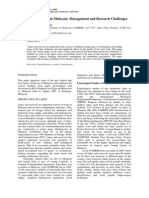More Water Hyacinth Invasion Looms Over Laguna Lake
More Water Hyacinth Invasion Looms Over Laguna Lake
Uploaded by
anon_611253013Copyright:
Available Formats
More Water Hyacinth Invasion Looms Over Laguna Lake
More Water Hyacinth Invasion Looms Over Laguna Lake
Uploaded by
anon_611253013Original Title
Copyright
Available Formats
Share this document
Did you find this document useful?
Is this content inappropriate?
Copyright:
Available Formats
More Water Hyacinth Invasion Looms Over Laguna Lake
More Water Hyacinth Invasion Looms Over Laguna Lake
Uploaded by
anon_611253013Copyright:
Available Formats
More water hyacinth invasion looms over
Laguna Lake
By Catherine Teves July 11, 2019
https://www.pna.gov.ph/articles/1074643
MANILA – The country’s largest inland body of water, the Laguna de Bay, is at risk of further proliferation of
free-floating water hyacinth, an invasive alien species (IAS), an official of an attached agency of the
Department of Environment and Natural Resources (DENR) said on Wednesday.
Jamella de Castro, DENR-Ecosystems Research and Development Bureau (ERDB) science research
specialist, said the worsening water pollution from continuing direct discharge of waste and untreated
wastewater into Laguna de Bay will promote water hyacinth’s proliferation.
“Water hyacinths thrive in water with poor quality,” she said at the sidelines of the ERDB-led IAS Conference
2019 in Manila.
She noted that these invasive plants multiply fast as well as threaten native aquatic biodiversity, ecosystems,
and composition of Laguna de Bay.
“It’s a major environmental problem in Laguna de Bay and other lakes,” she said.
According to the International Union for Conservation of Nature (IUCN), the world’s largest and most diverse
environmental network, invasive alien species are “plants or animals that are introduced by man, accidentally
or intentionally, outside of their natural geographic range into an area where they are not naturally present.”
“They are often introduced as a result of the globalization of economies, for instance by trade via ships,
shipment of wood products infested with insects, or the transport of ornamental plants that then establish
themselves into the wild and spread,” the IUCN noted.
De Castro said portions of the South Bay, including Laguna province’s San Pedro, Binan, Sta. Rosa, Cabuyao
and Calamba cities, as well as Los Baños and Bay municipalities, have the potential to drive the water hyacinth
proliferation.
She noted the said areas lack of sanitation and wastewater treatment facilities and discharge waste water
directly into the bay.
“The discharges are polluting South Bay’s waters, creating the condition conducive to water hyacinth’s
continuing growth and spread there,” she said.
De Castro urged the local government units these areas to help prevent further proliferation of water hyacinth,
like the passing of ordinance limiting quantity of fish feed dispensed in Laguna de Bay.
“Those with septic tanks there must have these desludged every five years,” she said.
She said there is a need for more research on Laguna de Bay's water hyacinth problem to better map out
strategic solutions. (PNA)
You might also like
- Amusement Park Design: How To Begin: Concept Development in The Feasibility StudyDocument5 pagesAmusement Park Design: How To Begin: Concept Development in The Feasibility Studyanon_611253013100% (1)
- Water Hyacinth: Bane or Boon?: Algal BloomDocument4 pagesWater Hyacinth: Bane or Boon?: Algal Bloomanon_611253013No ratings yet
- Characterizing The Water Quality of The CagayanDocument11 pagesCharacterizing The Water Quality of The CagayanMia BumagatNo ratings yet
- 2017 Plenary Paper Lasco RD 2Document4 pages2017 Plenary Paper Lasco RD 2Frianne FrondarinaNo ratings yet
- Water Lily Invasion' in Pasig River Due To Pollution'Document2 pagesWater Lily Invasion' in Pasig River Due To Pollution'anon_611253013No ratings yet
- 6A Reading Material Water HyacinthDocument3 pages6A Reading Material Water HyacinthRashmiRavi NaikNo ratings yet
- Gulf NewsDocument14 pagesGulf NewsAve RyNo ratings yet
- Laguna de Bay 2013 Ecosystem Health Report Card PDFDocument8 pagesLaguna de Bay 2013 Ecosystem Health Report Card PDFPEMSEA (Partnerships in Environmental Management for the Seas of East Asia)No ratings yet
- Water Pollution Group4Document8 pagesWater Pollution Group4Lash SoraNo ratings yet
- Final PaperDocument24 pagesFinal Paper23-58731No ratings yet
- Environmental Impact: Solving The Water Hyacinth Infestation Problem in The PhilippinesDocument1 pageEnvironmental Impact: Solving The Water Hyacinth Infestation Problem in The Philippinesanon_611253013No ratings yet
- Edited - CAGAYAN RIVER AND ITS TRIBUTARIES GROUP 14Document20 pagesEdited - CAGAYAN RIVER AND ITS TRIBUTARIES GROUP 14Sarah Joy MalsiNo ratings yet
- Bank Questions PC Virtual Unit 2Document13 pagesBank Questions PC Virtual Unit 2ScribdTranslationsNo ratings yet
- Raccon Creek ConservationDocument4 pagesRaccon Creek ConservationLord SquiggsNo ratings yet
- Microplastics 3 - WPS OfficeDocument5 pagesMicroplastics 3 - WPS OfficeAljun MorilloNo ratings yet
- RRL ForeignDocument5 pagesRRL ForeignMicah Dianne DizonNo ratings yet
- Earth SciDocument5 pagesEarth SciClarize Mae Apdohan Guce100% (1)
- July 2008 Wave Maker's NewsletterDocument4 pagesJuly 2008 Wave Maker's NewsletterGulf Restoration NetworkNo ratings yet
- Geography Project 2nd TermDocument6 pagesGeography Project 2nd Termavadhut.malji19No ratings yet
- Plenary II 2 - Water Quality Management. Key To The Sustainable Development of Laguna de Bay Carlito R. BarilDocument14 pagesPlenary II 2 - Water Quality Management. Key To The Sustainable Development of Laguna de Bay Carlito R. BarilJanno BataraNo ratings yet
- Current Trend of Water Hyacinth Expansion and Its Consequence On Thefisheries Around North Eastern Part of Lake Tana Ethiopia 2332 2543 1000189Document4 pagesCurrent Trend of Water Hyacinth Expansion and Its Consequence On Thefisheries Around North Eastern Part of Lake Tana Ethiopia 2332 2543 1000189banitessew82No ratings yet
- Rejuvenation of Water Bodies in Kerala-A Case Study of Kanampuzha River at Kannur DistrictDocument4 pagesRejuvenation of Water Bodies in Kerala-A Case Study of Kanampuzha River at Kannur DistrictAnshuman SinghNo ratings yet
- Critical Thinking PaperDocument12 pagesCritical Thinking PaperRebecca WynnNo ratings yet
- Lakes Great Again, But New Threats Loom (Dec. 01, 2015)Document12 pagesLakes Great Again, But New Threats Loom (Dec. 01, 2015)T.O. Nature & DevelopmentNo ratings yet
- Oreochromis Niloticus: Effects of The Lowest Chemical Toxicity of Bued River OnDocument8 pagesOreochromis Niloticus: Effects of The Lowest Chemical Toxicity of Bued River OnElian BiadoNo ratings yet
- TCW Fa3Document1 pageTCW Fa3Janric David CostillasNo ratings yet
- Thesis On River PollutionDocument8 pagesThesis On River Pollutionjqcoplhld100% (2)
- Waterfront Clean Up BlogDocument5 pagesWaterfront Clean Up BlogLasisi Adedoyin K.SNo ratings yet
- Water Hyacinth Proposal FinalDocument6 pagesWater Hyacinth Proposal Finalkaruna_srikureja100% (1)
- Zooplankton and White Goby (Glossogobius Giuris Hamilton 1822) : Correlation and Fishers' Perception in Selected Sites in Laguna de Bay, Luzon Island, PhilippinesDocument18 pagesZooplankton and White Goby (Glossogobius Giuris Hamilton 1822) : Correlation and Fishers' Perception in Selected Sites in Laguna de Bay, Luzon Island, PhilippinesMutya, Rosemarie Kate N.No ratings yet
- Harmful Algal BloomsDocument5 pagesHarmful Algal BloomsM RIZKI100% (1)
- What's Going On With Red TidesDocument4 pagesWhat's Going On With Red TidesvfontalvorodriguezNo ratings yet
- Calamba LagunaDocument13 pagesCalamba LagunaCJ GranadaNo ratings yet
- No To Black Sand Mining in Camarines NorteDocument2 pagesNo To Black Sand Mining in Camarines NorteKristine CatarojaNo ratings yet
- 5 Water Conservation PDFDocument18 pages5 Water Conservation PDFakbar aliNo ratings yet
- Malayan Colleges Mindanao: Bachelor of Science in Civil EngineeringDocument8 pagesMalayan Colleges Mindanao: Bachelor of Science in Civil EngineeringJam JasmineNo ratings yet
- 10-Article Text-28-2-10-20200413Document11 pages10-Article Text-28-2-10-20200413Nathalie Grace ToledoNo ratings yet
- WaterpollutionDocument3 pagesWaterpollutionrayane.dridiNo ratings yet
- 2017 Cornelia Blue Green AlgaeDocument1 page2017 Cornelia Blue Green AlgaeGoMNNo ratings yet
- Research Paper Asian CarpDocument9 pagesResearch Paper Asian Carpapi-488575092No ratings yet
- Water Pollution EAPPDocument4 pagesWater Pollution EAPPHiyesa Anne Gonzales MarcosNo ratings yet
- 66cc652a38fbcbb332a7e3ef NisipDocument3 pages66cc652a38fbcbb332a7e3ef NisipMr koyesNo ratings yet
- Water PollutionDocument7 pagesWater PollutionhudaNo ratings yet
- Summary 4Document1 pageSummary 4Vivian vicNo ratings yet
- Harmful Algae and Their Potential Impacts On Desalination Operations Off Southern CaliforniaDocument32 pagesHarmful Algae and Their Potential Impacts On Desalination Operations Off Southern CaliforniaBrigita de BrillarNo ratings yet
- Pollution and TourismDocument35 pagesPollution and TourismJunel AlapaNo ratings yet
- 2023 - Julia Et Al - Lakes and Reserviours - HABsDocument11 pages2023 - Julia Et Al - Lakes and Reserviours - HABsHorace Owiti O.No ratings yet
- INTRODUCTIONDocument4 pagesINTRODUCTIONkaitlyn bannisterNo ratings yet
- Consequences of Pollution and DegradatioDocument11 pagesConsequences of Pollution and DegradatioNayab GulNo ratings yet
- Gulf Narrows For Louisiana Shrimping Industry: Page 1 of 2Document3 pagesGulf Narrows For Louisiana Shrimping Industry: Page 1 of 2bob bobbobNo ratings yet
- MusselsDocument2 pagesMusselsNiko PaschaliNo ratings yet
- Group 6 Final ExamDocument7 pagesGroup 6 Final ExamKristofer RamosNo ratings yet
- Sabah Waste Water 2013 PDFDocument36 pagesSabah Waste Water 2013 PDFDon Baker100% (1)
- Assessment of Drinking Water Suitability in Low Income Rural Areas: A Case Study in Sixaola, Costa RicaDocument11 pagesAssessment of Drinking Water Suitability in Low Income Rural Areas: A Case Study in Sixaola, Costa RicaEdukondalu BNo ratings yet
- Conservat Sci and Prac - 2024 - Girard - Expansion of Fluvial Transport of Commodities Through The Pantanal Floodplains ofDocument9 pagesConservat Sci and Prac - 2024 - Girard - Expansion of Fluvial Transport of Commodities Through The Pantanal Floodplains ofrutjaimeNo ratings yet
- Holy Cross of Mintal, Inc. "The Potency of Bokashi Balls To Annihilate Water Impurities"Document5 pagesHoly Cross of Mintal, Inc. "The Potency of Bokashi Balls To Annihilate Water Impurities"Akissa (AKI)No ratings yet
- 490 Ijar-30672Document5 pages490 Ijar-30672Ericka De ClaroNo ratings yet
- Ethics Final Paper - Impacts of Fishing Industry To Marine LifeDocument11 pagesEthics Final Paper - Impacts of Fishing Industry To Marine LifeAmber Chavez100% (1)
- Factura NSC MT3 PresentationDocument14 pagesFactura NSC MT3 PresentationDanielle FacturaNo ratings yet
- Water Lands: A vision for the world’s wetlands and their peopleFrom EverandWater Lands: A vision for the world’s wetlands and their peopleNo ratings yet
- Building A Community ParkDocument10 pagesBuilding A Community Parkanon_611253013No ratings yet
- Amusement ParkDocument7 pagesAmusement Parkanon_611253013No ratings yet
- Planning and Executing Construction For Theme ParksDocument3 pagesPlanning and Executing Construction For Theme Parksanon_611253013No ratings yet
- Eichhornia CrassipesDocument8 pagesEichhornia Crassipesanon_611253013No ratings yet
- Deep History of Coconuts DecodedDocument5 pagesDeep History of Coconuts Decodedanon_611253013No ratings yet
- Coconut: Palm Species Arecaceae Genus Fruit SeedDocument9 pagesCoconut: Palm Species Arecaceae Genus Fruit Seedanon_611253013No ratings yet
- Coconut: EtymologyDocument21 pagesCoconut: Etymologyanon_611253013No ratings yet
- Environmental Impact: Solving The Water Hyacinth Infestation Problem in The PhilippinesDocument1 pageEnvironmental Impact: Solving The Water Hyacinth Infestation Problem in The Philippinesanon_611253013No ratings yet
- Farmers' Contribution To Improving The Value and Uses of Coconut Through The Maintenance and Use of Genetic DiversityDocument5 pagesFarmers' Contribution To Improving The Value and Uses of Coconut Through The Maintenance and Use of Genetic Diversityanon_611253013No ratings yet
- Importance of Research and DevelopmentDocument4 pagesImportance of Research and Developmentanon_611253013100% (1)
- Coconut Nutrition Facts: Health Benefits of CoconutDocument3 pagesCoconut Nutrition Facts: Health Benefits of Coconutanon_611253013No ratings yet
- Rizal-Chapter 14Document6 pagesRizal-Chapter 14anon_611253013No ratings yet
- Coconut: Physical DescriptionDocument2 pagesCoconut: Physical Descriptionanon_611253013No ratings yet
- Chapter 1 Fundamentals 2023Document11 pagesChapter 1 Fundamentals 2023Quân VõNo ratings yet
- Sewage Sludge and The Circular Economy - Final ReportDocument138 pagesSewage Sludge and The Circular Economy - Final ReportvzgscribdNo ratings yet
- Review On Comparison Between Waste Water TreatmentDocument4 pagesReview On Comparison Between Waste Water TreatmentrahulNo ratings yet
- Water Management in Industry04 PDFDocument15 pagesWater Management in Industry04 PDFWinmentolMalisaNo ratings yet
- Experiment 4.3: SamplesDocument3 pagesExperiment 4.3: Samplespubg boy ASNo ratings yet
- Cet304 Environmental Engineering, January 2024Document3 pagesCet304 Environmental Engineering, January 2024vpzfarisNo ratings yet
- Ese 122P-2 E01 T1 Sy2223 Finals - ResurreccionDocument2 pagesEse 122P-2 E01 T1 Sy2223 Finals - ResurreccionMa. Lalaine Nicole ResurreccionNo ratings yet
- The 2022 South Dakota Integrated Report For Surface Water Quality AssessmentDocument205 pagesThe 2022 South Dakota Integrated Report For Surface Water Quality AssessmentinforumdocsNo ratings yet
- EE&DM 7th Sem Mid Term PaperDocument1 pageEE&DM 7th Sem Mid Term PaperKrishna 1No ratings yet
- HTML Project 1Document6 pagesHTML Project 1Devanshu Agrawal 10D 3012100% (1)
- Water and Waste Water Engineering: Dry Weather FlowDocument10 pagesWater and Waste Water Engineering: Dry Weather FlowSanthoshMBSanthuNo ratings yet
- For 10 KLDDocument4 pagesFor 10 KLDrahul100% (1)
- Wastewater Treatment ActivityDocument4 pagesWastewater Treatment Activityapi-330472917No ratings yet
- Hydrology-Module 3-Phase 8Document3 pagesHydrology-Module 3-Phase 8nors lags100% (1)
- Renewable Energy EssayDocument6 pagesRenewable Energy Essayapi-639009097No ratings yet
- Narrator: This Is The Egypt Familiar To Most People. Cairo Is A Big, BusyDocument2 pagesNarrator: This Is The Egypt Familiar To Most People. Cairo Is A Big, BusyThúy PhươngNo ratings yet
- Biodiesel in ThailandDocument32 pagesBiodiesel in Thailandinfo_thesisNo ratings yet
- JXBW 8040 400FRDocument2 pagesJXBW 8040 400FRhosseinidokhtNo ratings yet
- 10 Soil Electrical ConductivityDocument14 pages10 Soil Electrical Conductivityfayis chNo ratings yet
- Domestic Waste Water Manual PDFDocument118 pagesDomestic Waste Water Manual PDFNoureddine MerahNo ratings yet
- Simple Method in Water Purification (Dr. J.N. Kardile)Document206 pagesSimple Method in Water Purification (Dr. J.N. Kardile)sumitanurag100% (1)
- Man and EnvironmentDocument18 pagesMan and EnvironmentSukhman Chawla100% (2)
- Script (Good Use of Water)Document2 pagesScript (Good Use of Water)zzbt7gy2qtNo ratings yet
- World Water Nov-Dec PDF of Chris D ArticleDocument5 pagesWorld Water Nov-Dec PDF of Chris D ArticleMrityunjay MallikNo ratings yet
- Seawater Intrusion Using Groundwater Modelling - MinjurDocument207 pagesSeawater Intrusion Using Groundwater Modelling - Minjuranup kumar sahuNo ratings yet
- Land Pollution - Mapua Pollution New ZealandDocument10 pagesLand Pollution - Mapua Pollution New ZealandOPGJrNo ratings yet
- Pathways To Net-Zero: Sbti Technical SummaryDocument22 pagesPathways To Net-Zero: Sbti Technical SummaryNicole Feliciano100% (1)
- Environmental ScienceDocument5 pagesEnvironmental ScienceKevin linsonNo ratings yet
- Lakes and Reservoir in Malaysia: Management and Research ChallengesDocument7 pagesLakes and Reservoir in Malaysia: Management and Research ChallengesasyrafmuhddNo ratings yet
- Biodegradable TestDocument10 pagesBiodegradable TestVarun VarunNo ratings yet










